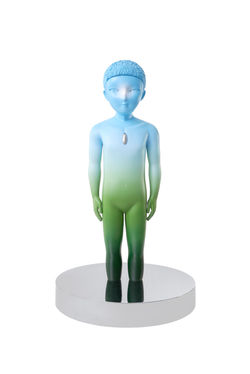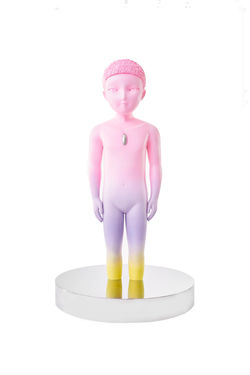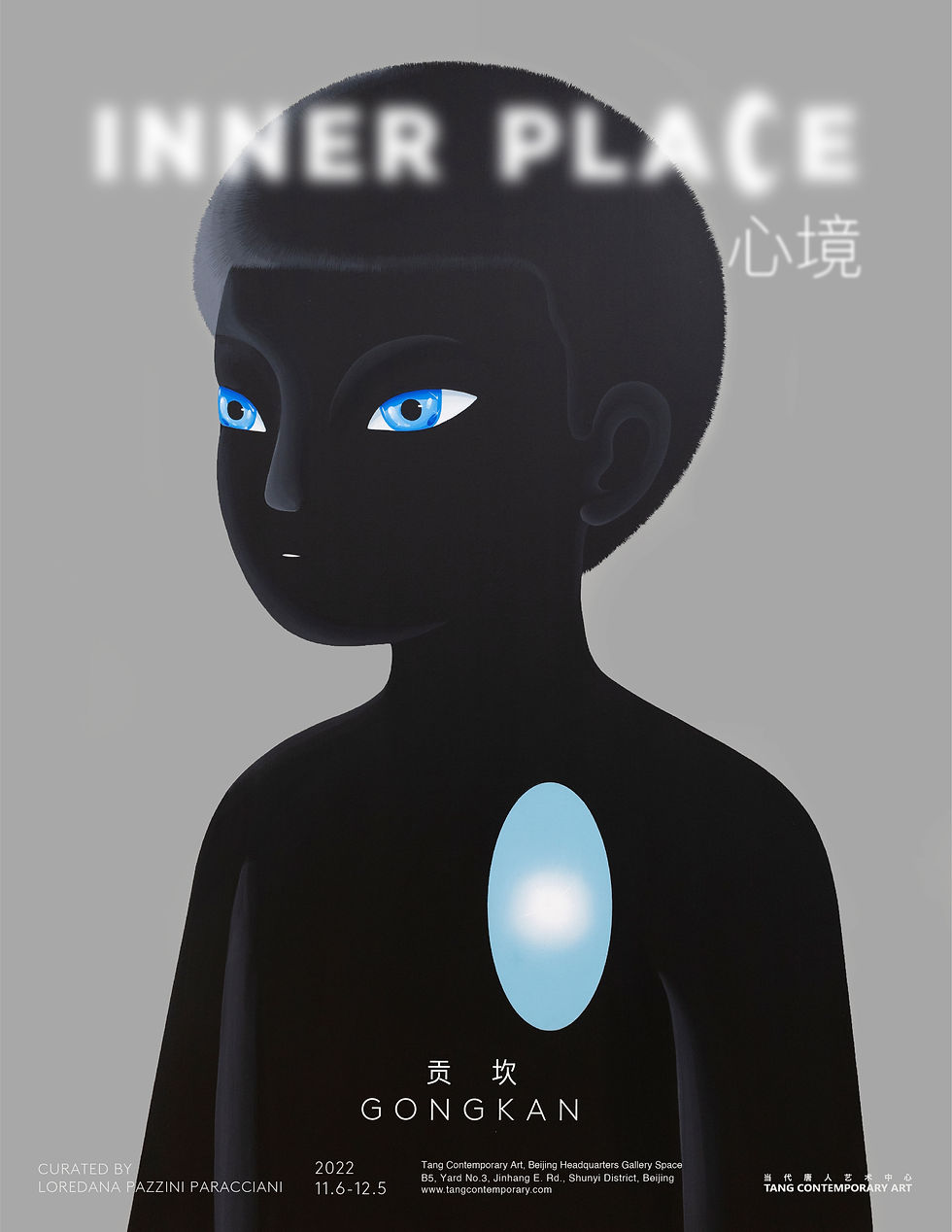Introspective journey: from social disturbance to self-acceptance
Curatorial essay by Loredana Pazzini-Paracciani
On one hand, we regard the image itself, which is flat, colourful and minimal. On the other hand, we need to confront its content, emotional, introspective and psychologically saturated. For Gongkan, these two apparently contrasting registers are reconciled through a visual language that is immediate yet capable of triggering deep, subconscious response.
A young artist, Gongkan has risen to fame in recent years with his communicative and highly relatable paintings and graphic works, including graffiti. After graduating from Silpakorn University in Bangkok, where he currently lives, he went on to pursue a career in advertising. In the early stages, he had moved to New York where he first encountered graffiti, and was exhilarated by its large scale, direct social communication and intrinsic anonymity that would enable him to unburden himself of the outsider feeling amid the US culture. At that point, Gongkan quit his advertising job and embarked on his art journey. In fact, since he was a child, he has been interested and gifted in drawing. As time passes, art has become an avenue through which he copes with social pressure, an escape to a place where he could nurture his own principles—such as friendship and mutual respect—values that are recurrent in his works.
In New York, he started experimenting with graffiti. And it is in New York that he developed his concept of the Souleport, a portmanteau of Soul and Teleport, illustrated as his trademark silver disc, a time machine that transports, so to speak, him and his viewers to an imaginary world of freedom and equality.
Resonating with imagery and iconography from pop art to surrealism, Gongkan has slowly but surely constructed a new visual language that is simple, accessible and poignant. Here begins, as mentioned earlier, the first register of his visual language, to be able to confront the image through a set of precise criteria of colourful, cartoon-like flatness and lightness as if his subjects were floating on the surface of the canvas. This very lightness and linearity of composition in his works is paralleled by an intensely emotional dimension. It is through this emotional channel that we enter the subsequent register of his visual framework: Gongkan’s own experience of coping with social pressure and, especially in the works for Inner Place, the importance of introspection in our daily lives. This psychologically saturated register also serves as a mirror of the times he lives in, growing up in conservative Thai society, and the languish of isolation enforced by the Covid-19 pandemic. In the years 2020–21, lives had been overturned by the chaos of the outbreak. Recent statistics in Thailand indicate increase in cases of depression and suicide as a result of financial insecurity and other struggles amid the pandemic, along with higher social pressure that youths face today—agonising to appear to be perfect or pretending to be who they are not. This boomerang trajectory from social disturbance to self-acceptance is something Gongkan incorporates in his art. The way he reconcile the fun with the serious, the cool with the emotional (because in social media terms one cannot be cool and sentimental), comes through the use of the advertising language acquired earlier in his career, which seeks to manipulate our vulnerabilities through its personal targeting.
The exhibition Inner Place is located here, accentuating the importance of self-acceptance that eventually leads to happiness on a roller coaster ride of emotions: sadness and joy, despair and excitement, love and hate. Featuring his nondescript boychild as a symbol of humanity, characterised by colours corresponding to emotional states, the newly commissioned works for Inner Place impel the viewers to examine the power that dominant emotions exercise in our lives.
Inner Place is composed of three main series: spray paint on canvas, spray paint on plexiglass (a new medium for the artist) and fibreglass sculptures. Through these works Gongkan takes the viewer on a journey into his emotions, allowing the viewer in turn to enter their own “inner place”.
The canvases are like no other— each work comprises two pieces that fit together like a jigsaw puzzle. The subject, his ungendered boychild, is situated at the centre within each frame. The colours and shapes are fantastical, a la Magritte, in whose surrealist paintings everyday objects are randomly placed with relatable human figures. Gongkan’s agender portraits have multicoloured and patterned skin, from stone-like to grass-covered; they have melting skin or complexions of deep blue and metallic grey. While the subjects are all different, each has similarly a hole where the heart is—a void in the canvas that nestles a smaller, inner canvas. Symbols such as a dove, a key, an eye, or clouds are painted on the small canvases. Abiding by the fundamental concepts of representational art, such symbols serve as mediary for the audience to read the work in its entirety, as if the smaller canvas conveys both the cause and the solution to the respective subject’s emotion. The idea of creating these binomial works is symptomatic of the way Gonkan perceives the flaws of our relationships with one another: although we may appear one way, our inner place is multilayered, complex. We need to take time to recognise who we really are.
With the plexiglass he further analyses the complexity of the human psyche, presenting full-body figures spray painted with stencils like graffiti. His signature boychild with arms open to his sides reminds the viewer of the Christ figure, and recurs throughout the series. What varies is the colour of each body and, by inference, its psychological state. Cool colours such as blues and greys to warm orange, pink and red hues impart a visual insight into how external stimuli elicit our emotional responses. The choice of spray painting on plexiglass instead of the usual canvas is also significant. In line with his intention to grasp the energy unleashed by our emotions, Gongkan needed a medium that was diaphanous yet solid, that was able to trace the ghostly, hidden image of ourselves. The suspended plexiglass works with their cast shadows achieve this.
Like the plexiglass works, the sculptures feature the same boychild, this time in a different pose. The posture is militaresque, arms firmly pressed to the sides and standing at attention. Once again, the variegated colours imply each figure’s individuality. Like a flame that rises, the colours flow in gradients, more saturated at the feet and diluting to different hues towards the head. Like the paintings, the heart of the boychild is suggested through a metallic oblong shape, a vulnerable chakra signifying love and compassion across the three series.
Representing our ability to love and connect with others, the emotions unleashed by our heart guide us through life. When our heart is out of alignment, we feel vulnerable and insecure. When we are discontented, we feel exposed and insignificant. When we pretend to be who we are not, we are not at peace; we feel hollow and envious of others. As the exhibition reveals, only by embracing life’s conflicting feelings through emotional agility can we accept our true selves, even as we ride the roller coaster journey from social disturbance to self- acceptance.




 You Can Unlock My HeartAcrylic on canvas on wooden board 160 × 120 cm ornament 30 × 15 cm 2022 |  The Colors of LifeAcrylic on canvas on wooden board 160 × 120 cm ornament 30 × 15 cm 2022 |  Under the Warming SunAcrylic on canvas on wooden board 160 × 120 cm ornament 30 × 15 cm 2022 |
|---|---|---|
 Strong As a Crystal, My Skin is MeltingAcrylic on canvas on wooden board 160 × 120 cm ornament 30 x 15 cm 2022 |  PurityAcrylic on plexiglass 200 × 122 cm 2022 |  MoonlightAcrylic on plexiglass 200 × 122 cm 2022 |
 LoveAcrylic on plexiglass 200 × 122 cm 2022 |  Love is Around Us, If Only We were Open to ItAcrylic on canvas on wooden board 160 × 120 cm ornament 30 x 15 cm 2022 |  I Need a Cool HeartAcrylic on canvas on wooden board 160 × 120 cm ornament 30 × 15 cm 2022 |
 ForeverAcrylic on canvas on wooden board 160 × 120 cm ornament 30 × 15 cm 2022 |  FreedomAcrylic on canvas on wooden board 160 × 120 cm ornament 30 × 15 cm 2022 |  Becoming a HumanAcrylic on canvas on wooden board 160 × 120 cm ornament 30 × 15 cm 2022 |
 Divine Light #6Fiber glass, stainless steel 180(H) × 106(Φ) cm 2022 |  Divine Light #7Fiber glass, stainless steel 180(H) × 106(Φ) cm 2022 |  Divine Light #4Fiber glass, stainless steel 180(H) × 106(Φ) cm 2022 |
Artist

Gongkan
Gongkan was born in 1989, Thailand, and currently works and lives in Bangkok, Thailand. After graduating from Silpakorn University, Gongkan moved to New York City to work in creative agency for three years. He used his spare time to create street art and illustrations, represented his hometown with the concept of "teleport art", and named his style of work "sensory art". " a man emerging from another dimension." Taking the visual world of a foreign land as a way out for self-substitution, Gongkan endows artistic expression with the relief and comfort of shuttling and began to create murals of similar styles on the walls in New York. In addition, he also made stickers of his black-hole voyagers and slapping them through the streets of New York, which gained attention in the local street art society.
In addition to teleporting through spaces, the element of time is also a predominant concept in Gongkan's paintings: On the surrealist canvas, he depicts human figures with interactive or lonely posture using flat graphic strokes, and suggests a tranquil texture with soft tones and smooth graphics. However, the peace revealed from his canvas is often blurred by the striking black form, and the almost deliberate contrast is endowed with poetic state at ease.
In 2019, he returned to Bangkok and quickly became the most representative new artist. His works both come from his own experience and reflect the real world around him. This mapping ability, no matter what secular challenges it faces, can always subtly touch the viewer. It lies not only in the vision of loveliness and dimensionality, but also in the expression of freedom and beauty. It is able to find a moment of peace and tranquility from any door it can shuttle through.
Selected solo exhibitions include: “Inner Place”, Tang Contemporary Art, Beijing, 2022; “Introspection: Gongkan Solo Exhibition”, Tang Contemporary Art Bangkok, Bangkok, Thailand, 2021; “Tip of the Iceberg”, Over the Influence, Los Angeles, 2021; “Yesterteday tomorrow”, River City Bangkok, Bangkok, 2019; “Teleport to Taiwan”, Taipei, 2019; “Black Area”, Funstown, Beijing, “Street Art with First Street Green Art Park”, New York City, United States, 2018; “The Another Dimension”, Siri House, Singapore, 2018. Selected group exhibitions include: “Vogue HOPE” by Vogue Magazine, Siam Center, Bangkok, Thailand, 2020; “Wonder Forest: Asian Illustration”, Powering Art Center, Xiamen, China, 2019; “Asia Illustration Fair”, Power Long Museum, Shanghai, China, 2019; “Lucid Exhibition”, Seoul, South Korea, 2016; “The Warmest Winter”, New York City, United States, 2016.
Curator

Loredana Pazzini-Paracciani
Loredana Pazzini-Paracciani is an independent scholar and curator of Southeast Asian contemporary art. Her research and curatorial practice revolve around critical sociopolitical issues in Southeast Asia, advocating a counter-hegemonic and non-West- ern-centric discourse. Her articles have appeared in several academic journals such as Visual Anthropology, Routledge UK; Photographies, Routledge and University of Westminster UK; Frames Cinema Journal, University of St. Andrews, UK; Convo- carte: Revista de Ciências da Arte, Lisbon University, Portugal; and M.A.tter Unbound, LASALLE College of the Arts, Singapore, among others. Together with Patrick D. Flores, she co-edited the anthology Interlaced Journeys: Diaspora and the Contemporary in Southeast Asian Art, published in 2020 by Osage Art Foundation, Hong Kong.
Notable museum exhibitions she has curated include Déjà vu: When the Sun Rises in the West solo show by Natee Utarit at Silpakorn Art Center, Bangkok (2022); Homecoming /Eventually at UP Vargas Museum, Manila, Philippines (2021); Diaspora: Exit, Exile, Exodus of Southeast Asia at MAIIAM Contemporary Art Museum, Thailand (2019); and Architectural Landscapes: SEA in the Forefront for InToAsia: Time Based Art Festival 2015 at Queens Museum, New York. In 2022 Loredana was invited to curate the online program for the ASEAN-EU Cultural Festival titled “Youth Voices” to celebrate the 45th anniversary of ASEAN-EU cross-cul- tural relations.
Loredana is one of the appointed curators for the Bangkok Art Biennale 2022.



